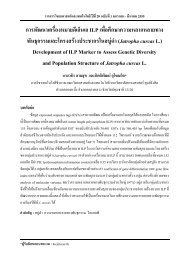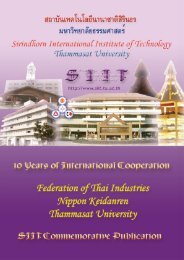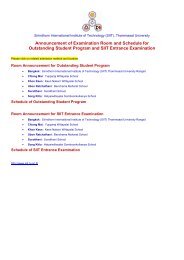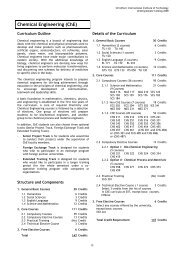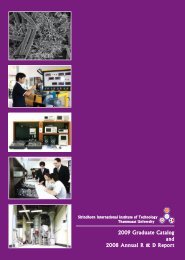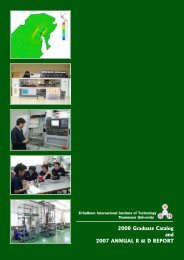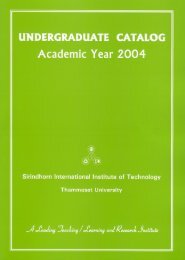2006 Graduate Catalog and 2005 Annual R & D Report - Sirindhorn ...
2006 Graduate Catalog and 2005 Annual R & D Report - Sirindhorn ...
2006 Graduate Catalog and 2005 Annual R & D Report - Sirindhorn ...
You also want an ePaper? Increase the reach of your titles
YUMPU automatically turns print PDFs into web optimized ePapers that Google loves.
<strong>2006</strong> <strong>Graduate</strong> <strong>Catalog</strong> <strong>and</strong> <strong>2005</strong> <strong>Annual</strong> R & D <strong>Report</strong><br />
<strong>Sirindhorn</strong> International Institute of Technology (SIIT)<br />
Development <strong>and</strong> Study of Fluidized Bed<br />
Combustion Systems for Firing Biomass Fuels<br />
Biomass is one of the major primary energy sources<br />
in Thail<strong>and</strong>. Residues <strong>and</strong> wastes collected on a large<br />
scale from agricultural <strong>and</strong> forest-related activities<br />
such as rice, sugar, wood <strong>and</strong> palm oil industries can<br />
be used (alternatively to fossil fuels) as energy<br />
sources for heat <strong>and</strong> power production in this country.<br />
Thus, the development of highly efficient, reliable <strong>and</strong><br />
environmentally friendly technologies for biomass<br />
utilization with the aim of energy production, is a<br />
problem of paramount importance for the Thai energy<br />
sector. Due to some advantages, fluidized bed<br />
combustion technology seems to be the most suitable<br />
for energy conversion of biomass. Conical fluidizedbed<br />
combustors of various modifications have been<br />
proposed <strong>and</strong> are being studied. The research<br />
objectives include: (1) investigation of fluidization<br />
characteristics of the bed material in conical<br />
prototypes; (2) study of the effects of fuel <strong>and</strong> bed<br />
material types as well as operating conditions<br />
(including air staging) on the combustion efficiency<br />
<strong>and</strong> emission characteristics of the combustor; (3)<br />
study of the physical <strong>and</strong> chemical factors affecting<br />
formation <strong>and</strong> reduction of major pollutants in the<br />
combustor; (4) optimization of the combustor design<br />
<strong>and</strong> its operating conditions; (5) assessment of<br />
environmental impacts for various biomass fuels; (6)<br />
study on co-firing of different biomass fuels <strong>and</strong>/or cofiring<br />
of biomass with coal in a conical fluidized bed.<br />
Department of Common <strong>and</strong> <strong>Graduate</strong> Studies<br />
Faculty Members <strong>and</strong> Research Interests, <strong>2006</strong><br />
Dr. Alice Sharp<br />
Assistant Professor<br />
B.Sc. in Biology, Chiang Mai University, Thail<strong>and</strong><br />
M.Sc. in Environmental Risk Assessment, Chiang Mai University, Thail<strong>and</strong><br />
M.Sc. in Natural Resource Management, Hiroshima University, Japan<br />
Ph.D. in Natural Resource Management, Hiroshima University, Japan<br />
Areas of Specialization: Community based natural resource management, Environmental Impact Assessment,<br />
Pollution monitoring.<br />
Research Interests:<br />
Community Based Environmental Protection<br />
(CBEP)<br />
CBEP is a new approach to environmental protection.<br />
Traditionally, environmental protection programs have<br />
focused on the comm<strong>and</strong> <strong>and</strong> control approach,<br />
which have been very effective at reducing point<br />
source pollution <strong>and</strong> improving environmental quality.<br />
However, some environmental problems, such as<br />
non-point source pollution are less amenable to these<br />
programs. CBEP will supplement <strong>and</strong> complement<br />
the traditional environmental protection approach by<br />
focusing on the health of an ecosystem <strong>and</strong> the<br />
behavior of humans that live in the ecosystem’s<br />
boundaries. This study is aiming to 1) comprehensively<br />
identify local environmental concerns, 2) set<br />
priorities <strong>and</strong> goals that reflect overall community<br />
concerns, <strong>and</strong> 3) develop comprehensive, long-term<br />
solution to environmental problems.<br />
Products Life-Cycle Assessment (LCA)<br />
Life-cycle assessment (LCA) is used to quantify the<br />
environmental inputs <strong>and</strong> outputs of a product or<br />
process, from the mining of raw materials, through<br />
production, distribution, use <strong>and</strong> reuse or recycling, to<br />
final disposal. There are two main stages of LCA:<br />
inventory analysis <strong>and</strong> impact assessment. Inventory<br />
analysis involves the quantification of environmental<br />
inputs <strong>and</strong> outputs throughout a product or process’s<br />
lifetime. The inventory analysis is aiming to identify a<br />
list of pollutants that may have an impact on the<br />
environment. The purpose of the impact assessment<br />
is to aggregate <strong>and</strong> evaluate the potential<br />
environmental impacts identified in the inventory. This<br />
study will be focusing on particular kinds of waste<br />
which have high potential to be a major environmental<br />
problem in the future, mobile phone <strong>and</strong> its batteries,<br />
as an example in order to develop waste<br />
management plan <strong>and</strong> minimize the amount of waste<br />
before h<strong>and</strong>.<br />
Waste Management<br />
Waste management is one of the major long-term<br />
problems in our society. Cost-effective, environmentally<br />
sound management of wastes continues to<br />
be an unstable issue, the solution of which must<br />
integrate science, technology, individual awareness,<br />
<strong>and</strong> policy. Waste management begins with<br />
underst<strong>and</strong>ing the complete <strong>and</strong> detailed physical,<br />
chemical, <strong>and</strong> biological characteristics of the waste<br />
in question. This underst<strong>and</strong>ing is crucial to<br />
successful utilization or environmentally sound<br />
disposal measures. Additionally, waste management<br />
enables us to predict what is in a material, how much<br />
is there, how it may leach out, <strong>and</strong> how it will<br />
ultimately impact the environment.<br />
37




